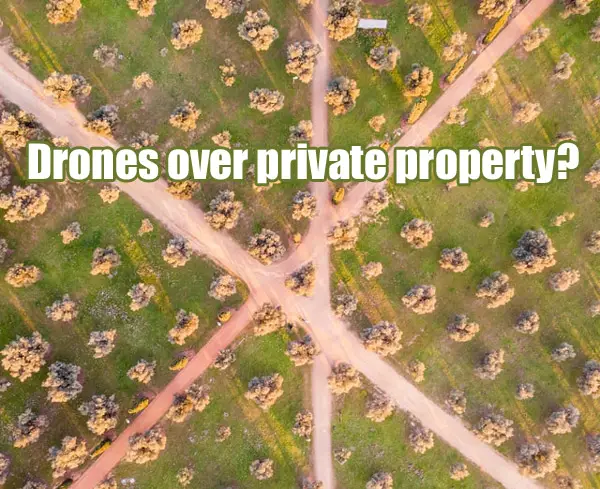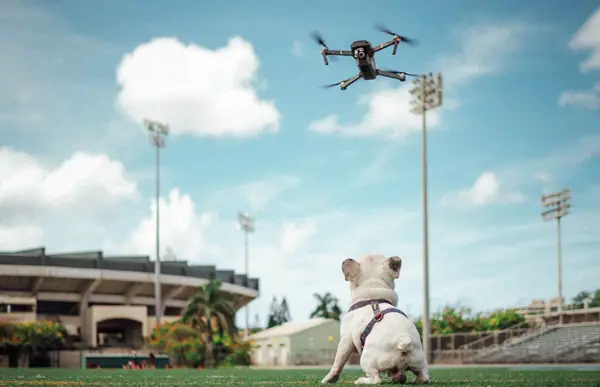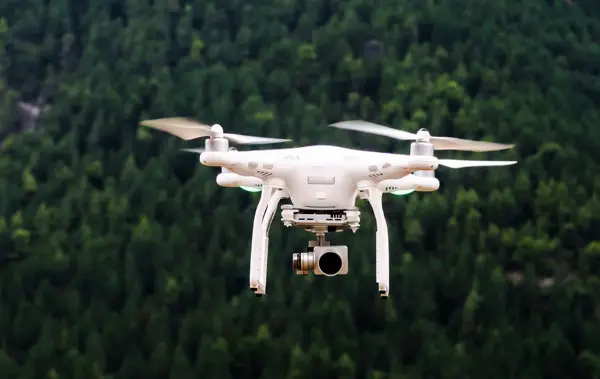Drone photography and videography are becoming big business, from real estate to special effects such as simulating views from aircraft or a bird’s eye. Aerial photography can be simply stunning and even abstract which makes for great photos.

With money out there and more and more people getting into using drones for photography, legal questions arise over what you can fly over and take photos of. In this article, I will explain the legalities of flying drones over private property and related issues.
As a general rule, it is legal to fly a drone over private property if the flight rules are followed and you fly outdoors, as property owners do not own the airspace, as long as you are not causing a nuisance or flying recklessly. Exceptions include states which passed laws restricting the flying of drones in private places.
Let’s get into the specifics and details including photographing private property. But first, just remember to keep in mind that if you are looking to fly a drone in any area, you need to check the drone laws in that area.
Sometimes, it may not be legal to fly drones in a specific area. The laws for flying drones in the United States are completely different from the European drone laws. If you intend to fly drones in any of these places, then it is essential to know the rules there. Always be proactive and research the local laws, its better to be on the safe side than in trouble.
Laws regarding photography and videotaping
The laws regarding photography and videotaping will be different for different countries. For example, In the US, these laws vary according to the jurisdiction. So, what is legal in one place can be illegal in other.
Generally, it is considered legal to photograph anyone on public property with appropriate standards. You can do photography or videography in a tourist place, that is private or public if it is allowed there. The general rule is that unless its specifically forbidden by some sort of sign, it is allowed.

If it is non public access private property, then you need to get the consent of the property owner to do photography or videotaping. Otherwise, you may end up with unnecessary issues.
Can drones take pictures of private property?
The flying of drones in the airspace of private property is acceptable as per FAA if the flight height is within the acceptable limits. But, if you try to take pictures of the private property, then you have to consult the local state privacy laws. You should not take pictures of private property unless you have permission from the private property owner.
What are the privacy laws for drones?
The drone privacy laws vary for different countries. The privacy law followed by the US will be completely different from that of Europe or India. So, it is essential to know the privacy law of that region before starting to use a drone in that place.
The Federal Aviation Administration does not officially get involved in privacy issues and only focuses on proper drone flight height and restricted no fly zones along with the requirements for commercial drone use. This is also because privacy laws do not change depending on how you photograph, whether its with a telephoto lens on a tripod or using a drone, even if drones make it much easier to invade privacy these days. The National Telecommunications and Information Administration instead has Guidelines for Neighborly drone use.
The issue of privacy laws is not a simple one because drone operators should be able to take photos for the sake of art as well as reporting events according to the First Amendment, as long as the drone stays below 400 feet. Even neighboring states have very different laws in this regard, which are meant to protect individuals from being spied on on their property or photographed through windows, whether using a drone or not. It is best to consult local laws.
Do property owners own the airspace?
The FAA has declared that the UAS (Unmanned Aircraft System) is under federal law. The UAS can fly in almost all places except prohibited ones. As per FAA, the airspace that can be used by the drone includes all the airspace except indoors. Thus, the drone that is flying over your yard or private space can do so since it is navigable airspace. So, the private property owners cannot interfere with the flying of a drone over their private property unless it is low flying, a nuisance, or reckless. The property owners do not own the airspace.
Can You Be Sued for Flying a Drone Over Private Property?
There are no federal laws in place that restrict you from flying a drone over private property. The restriction is only on the height at which you are flying. It must not cross the 400 foot mark. But, some of the states in the US have passed local laws that restrict the flying of drones in private places. So, if you use your drones in such areas, then there is a chance that you can get sued. So, always cross-check and ensure that the private property where you are flying the drone does not have any such restrictions.
However, flying a drone at low altitude which would interfere with anyone or their possessions on their property is a no no.
Is it legal to destroy a drone over private property?
Sometimes drones can be a nuisance to private property owners. However, if someone tries to shoot down the drone, they may have to face civil and criminal penalties. So, it is always better to ask the drone operator not to fly the drone above a property if there is an issue.

If someone wants to complain about the drone, they can get in touch with the local enforcement office in the area. They can easily find the drone pilot. The law enforcement officers can take necessary action if the drone pilot has violated any of the drone flying rules.
It is illegal for private property owners to destroy the drones that fly over their property. They are not allowed to disrupt the operation of any drone while in flight. So, they cannot shoot or damage the drone by any means. They must not use trained birds to attack the drone or use nets for capturing the drone.
Laws in the United States and Europe
We will have a look at the drone laws in the US and Europe in some detail. It will help you to get a better understanding of the legal side of drones in general, which anyone using drones for photo or video must know.
Different countries have got different sets of rules for flying drones, so is the case with the United States of America and Europe.
Drone Laws in the United States
In the United States, flying drones can come under two categories. It will be either for recreational purpose by hobbyists or commercial purpose by professionals.
If it is for recreational purpose, then you need to follow the set of rules mentioned below.
You need to ensure that the purpose is pure recreational and there are no monetary benefits involved. The US Federal Aviation Authority (FAA) also demands one to take The Recreational US Safety Test (TRUST). You can attend the online training provided on their site.
The drone that you are using needs to be registered on the FAA drone zone website. You must also ensure to fly the drone always in your line of sight.
The weight of the drone used must be less than 55 lbs. If the drone is heavier than that then you need to get it certified by a community-based organization. You need to ensure to follow all the safety guidelines prescribed by the community.
It is also necessary to ensure not to fly the drone near any other aircraft. You must also make sure not to fly drones near emergency response efforts.
There is specific airspace called the Class G airspace, and you are allowed to fly drones only in this allotted airspace. The airspace B, C, D, and E come under the controlled airspace category. So, if you wish to fly your drones in any of these airspaces you need to get approval from the airspace. You can always have a look at the LAANC authorization guide if you are really interested in getting one.
Now, we will have a look at the commercial rules for flying drones in the United States. A commercial license for flying drones in the US will allow you to fly them in the Class G airspace. You can also bypass the Class G limitation if you get special authorization from the FAA.
There is a speed limit of 100 mph for the drones. The drone must be always below 400 feet.
The drone must be always in your line of sight.
If there is a manned aircraft in the way, then you must give way for it and must not cause any interference for the aircraft. The total weight of the drone must be less than 55 lbs. The drone must be registered on the FAA drone zone website. You need to get a Remote Pilot Certificate from the FAA to fly drones in the US commercially.
It is possible to waive off many of the above-mentioned requirements, except the Class G and weight requirements if you can get a Part 107 waiver from the FAA.
Drone Laws in Europe
Like the US, Europe also differentiates the drone use between commercial and hobbyist use. So, the rules vary for each of these two categories. The rules for using drones in European countries are set by the European Union Aviation Safety Agency (EASA). Earlier, drone rules were different for different European nations. Now, it is the same for all the European nations including the United Kingdom.

In the case of hobbyist use, drone use is limited to private use for photography and videography. You need to register your small drones also in EASA.
EASA has grouped the drones into 3 categories.
Open category drones
These are drones that are identified as low-risk drones that do not require any specific authorization. But, there will be operational limitations applicable to the drones in this category.
Such drones will have identification labels as 0, 1, 2, 3, and 4. The maximum total weight of these drones will be 55 lbs.
The pilot who is controlling these drones needs to make sure that the drone is always at a safe distance from people.
The drone must be always under the visual line of sight of the remote operator. The drone must not drop any goods or carry any dangerous items during the flight. You must not be flying the drone above 400 feet.
You can fly the drone above the people only if the drone has a weight of fewer than 250 grams or if it belongs to that particular class label.
The open category is further divided into 3 categories.
- A1 drones
Drones that are labeled C0 must have weight less than 0.55 lbs. If the labeling is C1, then the weight must not cross 1.98 lbs. It will have a label identification of 1 or 0. If there is a CE marking on the drone, then the remote operator needs to get registered from EASA. You must not fly the drone above 42 mph. These drones must not be used in prohibited areas and near large crowds of people.
- A2 drones
These drones will be marked with a class label 2. The person using the drone must be more than 16 years old. The maximum weight of the C2 drones must not go beyond 8.81 lbs. These drones cannot be used in prohibited areas and in large crowds. The flight of the drone must be always 98 feet away from the people.
- A3 drones
Any drones that weigh more than 2 kilograms will come under this category. These drones must not be flown near people. The age of the drone operator must be 16 years or more. These drones will be labeled as C3 or C4. The weight of these drones must be below 4 kgs. The drone must maintain a minimum distance of 492 feet from the people if it is flown in urban areas.
Specific category drones
These are medium-risk category drones. Such drones need to get the necessary authorization from the National Aviation Authority (NAA). The authorization will be done after doing a risk assessment.
Such drones can be operated only as per the instructions shared by the EASA or the NAA. The drone operator must submit a declaration to the NAA to ensure the operation of the drone as per NAA guidelines. If the drone operator wishes to deviate from the standard scenario prescribed by NAA, then the operator needs to do a predefined risk assessment (PDRA) for getting the NAA’s approval. Only, a drone operator who has the Light UAS Operator Certificate can fly drones that come under the specific category.
Certified category drones
These are high-risk category drones. They need to follow all the rules put forward by the aviation department. The flying height of the drones is restricted to 400 feet or 120 meters, which is the same as the US restriction.
Certification requirements for the operator
Except for the C0 category drones, all other drone operators need to undergo an online training course to use a drone in any of the European countries. This training is only exempted for C0 drones, which are lightweight ones. The drone operator who uses a C0 drone must have a good understanding of the instructions for operating the drone.
If you want to use a drone that comes under the specific category, then the operator must have a remote pilot theoretical knowledge certificate. He/she must complete the STS-01 practical skill training.
Drone laws for foreigners in Europe
If you are taking your drone to Europe, then EASA has set up some rules and regulations that you need to follow.
If your drone comes under the open category, then you need to follow the following set of rules:
Your drone must be registered with the NAA. The registration number that is issued must be put as a sticker on the drone. You must also enter the registered number in the Remote Identification System of your drone. You can use the same registration in all the European countries. The drone operator must ensure to follow the drone regulations of each state.
If you wish to use the drone in a specific category, then you need to submit the request for the same. You can use it only after NAA approves your request.
If you are interested in learning more about drone laws in the US, then watch this video from Chris and Sara:
I you are into drones as a photographer, consider reading this article on tips to improve your drone photos and videos.









3 comments